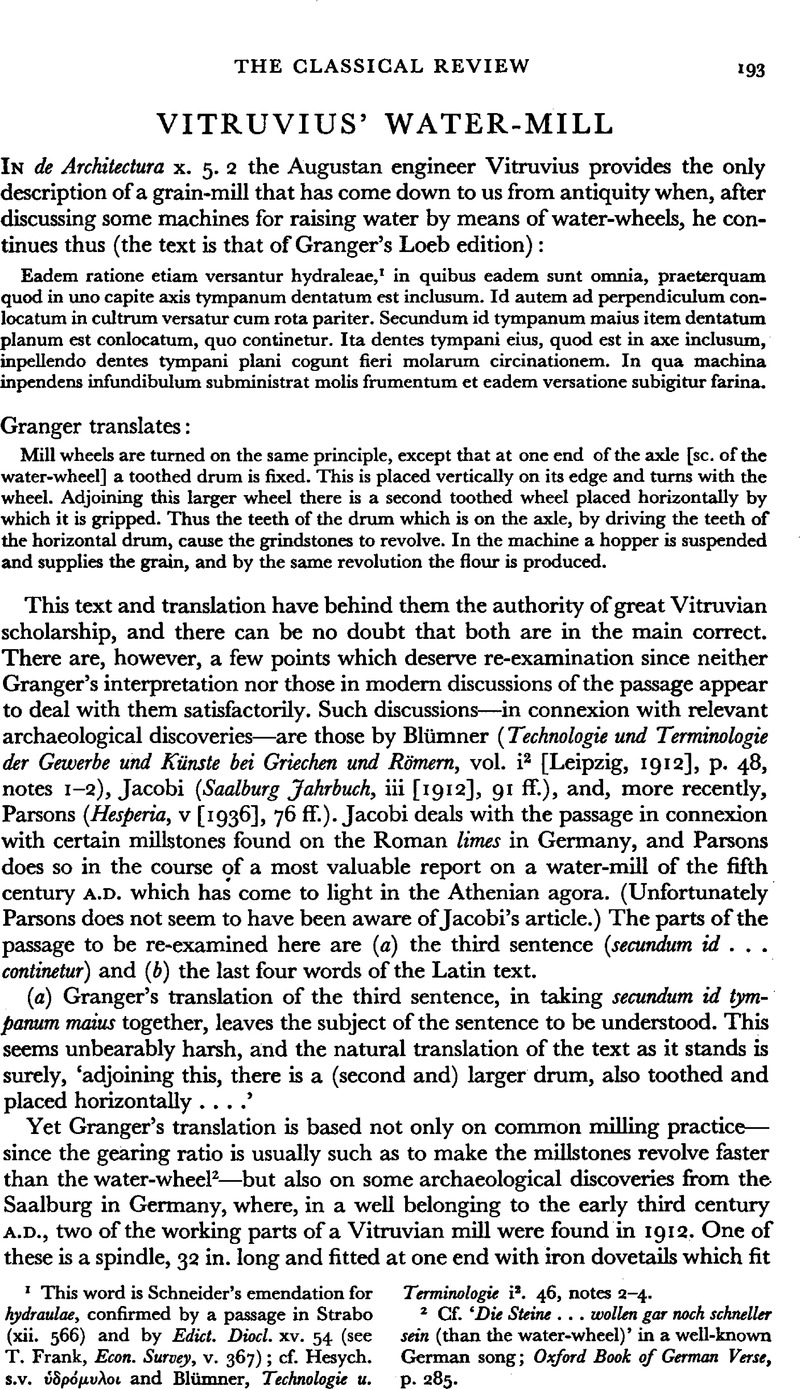Article contents
Vitruvius' water-mill
Published online by Cambridge University Press: 13 February 2009
Abstract

- Type
- Review Article
- Information
- Copyright
- Copyright © The Classical Association 1956
References
page 193 note 1 This word is Schneider's emendation for hydraulae, confirmed by a passage in Strabo (xii. 566) and by Edict. Diocl. xv. 54 (see T. Frank, Econ. Survey, v. 367); cf. Hesych. s.v. ὑδρόμυλοι and Blümner, Technologie u. Terminologie i2. 46, notes 2–4.
page 193 note 2 Cf. ‘Die Steine … wollen gar noch schneller sein (than the water-wheel)’ in a well-known German song; Oxford Book of German Verse, p. 285.
page 194 note 1 e.g. Rose (Leipzig, 1867 and 1899), Morgan, Reber, and Prestel; cf. Jacobi, loc. cit., pp. 92–93.
page 194 note 2 This conjecture may be connected with a mistaken idea, expressed in Overbeck-Mau, Pompeii 4, p. 388, that Vitruvius' water-mill made use of stones like those belonging to the ‘hour-glass’ mills familiar from Pompeii. In fact, however, archaeological discoveries have shown that the stones of Roman water-mills were of quite a different shape and much more like modern millstones than those of the Pompeian animal-mills.
page 195 note 1 Granger, vol. 1, p. xxiv.
page 195 note 2 Indeed axis habens in summo capite subscudem ferrtam exactly describes one of the two parts found by Jacobi.
page 195 note 3 Cf. Vitr. iv. 7. 4, and Fest. p. 307 Müll.
page 195 note 4 With the notable exception of Blümner, pp. 48 and 64 n. 4.
page 195 note 5 e.g. Cato, Agr. 74, farinam in mortarium indito, aquae paulatim addito subigitoque pulchre. ubi bene subegeris, defingito …; [Virg.] Moret. 47 f., iamque subactum levat opus; cf. Cato, Agr. 18. 7; 76. 1; Plin. N.H. xviii. 105; Cato ap. Plin. N.H. xvii. 111.
page 195 note 6 Cf. perdomare in Sen. Epist. 90. 23; also Blümner, p. 61 n. 2.
page 195 note 7 e.g. Cic, Leg. ii. 18. 45; Virg. Georg. i. 125; Ov. Met. xi. 31.
page 195 note 8 An apparent exception occurs in Plin. N.H. xxii. 127 (farina in pollinem subacta). Here subigere seems to mean ‘to (re-)grind’; but the whole section is omitted in some manuscripts, and redacta appears in others. Even if genuine, the passage rests on Dioscor. M.M. ii. 85 (Wellmann), and the words in question may well be a mistranslation on Pliny's part.
- 2
- Cited by




